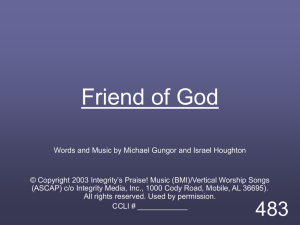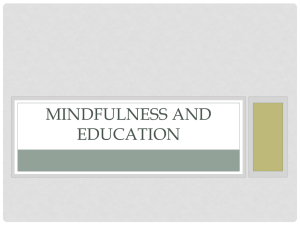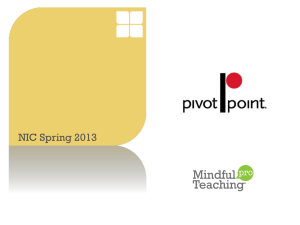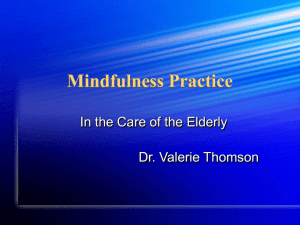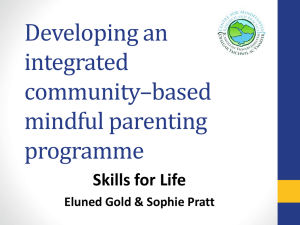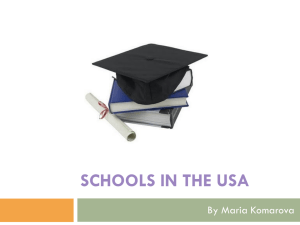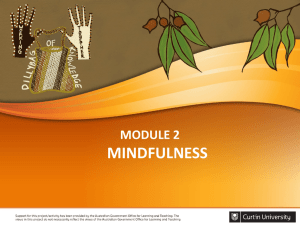The Mindful Edge - Discover Mindfulness
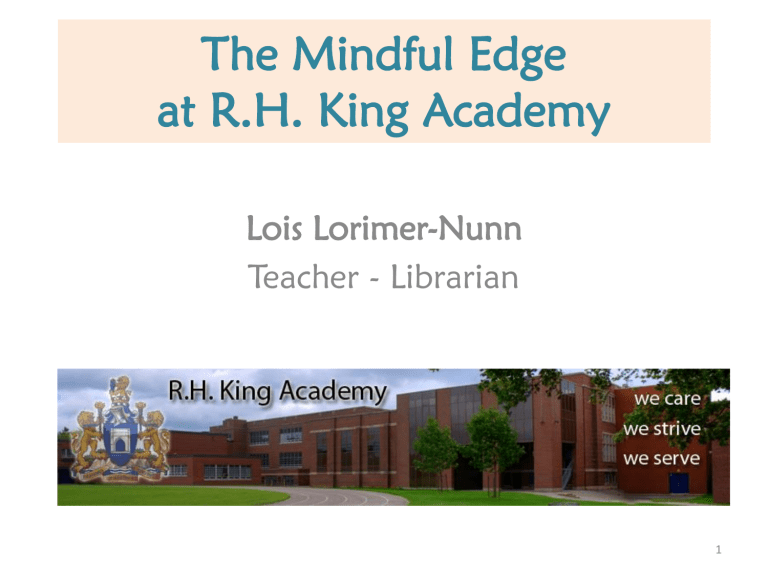
The Mindful Edge at R.H. King Academy
Lois Lorimer-Nunn
Teacher - Librarian
1
Context
• Stepping Stones:
A Resource on Youth Development 1
– Understanding youth development: Cognitive,
Emotional, Social & Physical
– Transitions, resilience, & positive supports
• Asset-focused approach includes:
– Building on strengths (positive psychology)
– Meditation
– Core concept: “Sense of self”
1 Ministry of Youth and Youth Services (ages 12-25)
2
Engaging “Self” in Youth Development
Self/Spirit – Enduring (yet changing) core Image from Stepping Stones 2012
3
New Curriculum Document
• Social Sciences & Humanities (grades 9-12)
– Supporting students’ well-being & ability to learn
– Mental health, resilience, & overall well-being
• “Well-being is influenced not only by the absence of problems and risks, but by the presence of factors that contributed to healthy growth and development.” www.mindfulnesseveryday.org
4
Creating a Mindful Culture
School-wide
Spring 2011: The Mindful Edge ™ after-school program
Fall 2011 to present:
• The Mindful Edge for Grade 11 Leadership classes
• Action Research Study
• The Stress-Less Club drop-in sessions
• The Mindful Minute – Give Your Brain A Break
Fall 2012: Mental Health Literacy Curriculum
Fall 2013: SMART in EDUCATION™ Training for Educators
5
Looking at Stress
6
What stresses students?
2011 TDSB Student Census
A. Students’ Worries: Grades 7+8 versus Grades 9-12
7
What stresses students?
2011 TDSB Student Census
B. Students’ Positive Feelings: Grades 7+8 versus Grades 9-12
8
Social and Emotional Well-being
Grades 9-12
C. Emotional Challenges: Grades 9-12
9
Social and Emotional Well-being
Grades 9-12
D. Physical Symptoms: Grades 9-12
10
TEENAGE BRAIN
NEUROSCIENCE: Effects of chronic stress, abuse, or neglect:
– Brain’s plasticity makes it vulnerable to stress AND open to intervention
– Energy into “stress-activated” areas of the brain at expense of other “thinking-activated” areas
– Quick & strong physiological stress response in adolescents because the prefrontal (regulation) cortex is immature
– “Fight or flight” response overwhelms attention, impulse control, sleep patterns, and fine motor control
– High activation of limbic system affects perception
(Fear Dangerous world; Calm Peaceful world)
– Stressed brains focus us on survival, not learning and development of social & cognitive skills
11
The Mindful Edge
™
Stress Reduction and Life
Strategies for Teens
Goal: Empowerment – Skills for being with the ups and downs in life
Lesson 1 Introduction to Mindfulness & the physiology of Stress
Lesson 2 Foundations of Mindfulness: Mindful Attention Breath & Body
Lesson 3 Perception & Thinking Out of the Box, Neuroscience
Lesson 4 Mindfulness of Thoughts
Lesson 5 Paying Attention to Emotions (Feelings) / Moods
Lesson 6 The “About to” Moment – Making Wise Choices
Lesson 7 Communication – Relationships: Mindful Speaking & Listening
Lesson 8 Me to We: The Mindful Connection
Field Trip Interconnectedness – Mindfulness of the Environment
12
Question #1 - Does The Mindful Edge program improve students’ abilities to recognize and identify symptoms of stress?
13
Question #2 - If so, are they adopting more effective strategies when trying to reduce the unhealthy effects of stress?
14
Scheduled Stress Lowering Clinics
Stress Less Club Clinic
15
Quiet Zones with Low Lighting
16
Benefits of Mindfulness for Students
• Supports “readiness to learn”.
• Promotes academic performance.
• Strengthens attention and concentration.
• Reduces anxiety before testing.
• Promotes self reflection and self calming.
• Improves classroom participation by supporting impulse control.
• Provides tools to reduce stress.
• Enhances social and emotional learning.
• Fosters pro-social behaviours and healthy relationships.
• Supports holistic well-being.
From Mindful Teaching and Teaching Mindfulness, A Guide for Anyone Who Teaches Anything by Deborah Schoeberlein
17
Mindfulness is…..
Paying attention to your life, here and now, with kindness and curiosity
Dr. Amy Saltzman
18
What Students Say About TME…
1. What did I learn in this program?
• I learned how to listen to others, really listen to them instead of saying everything you want to say.
• How to eat mindfully and really savour the food you eat.
2. What’s the most important message for me?
• Use mindfulness when talking, listening, wanting to study for a test, etc.
3. How will I use what I learned in life?
• In life when someone says something I really do not like, I use mindfulness to think about it and give a response instead of a reaction, where the consequences may be negative.
*
I learned how to control my mind through stressful and horrible times.
Before when I approached a problem and it made me angry, I would be physically violent. Now, I use these mindful skills and think before I react to any sort of problem. Also, I have learned how to relieve the stress and get it all out by doing mindful yoga. This course helped me a
19
The Mindful Minute
Give your brain a break……
Summary:
• Sit in a comfortable position with a straight back, eyes closed or with a soft gaze.
• Allowing your body to become still, as best you can.
• Allowing your mind to settle, as best you can.
• Following the feeling of the breath as you inhale and exhale.
• Breathing in…Breathing out…
• If your attention wanders, as it will, gently return your attention to the feeling of breathing in and breathing out.
Taking three mindful breaths can help calm your body, which can relax your mind, and help you respond with awareness in challenging situations.
20
Mindful
Minutes
• 3-minute sitting meditation or
“brain break” school-wide
• Music and narration by students with help from The Mindful
Edge
• Teacher training
• Parent Council
• Grade 8 Transition
21
More Contributors to Wellness
22
SMARTinEDUCATION™
Stress Management and Relaxation Training for Educators
• Evidence-based program
• Addresses skill gaps of educators (K-12)
• Helps professional support staff
• Fosters calmness needed by students.
Develops ability to recognize, tolerate, and transform responses to challenging emotions through exercises and discussions connected to the experience in the classroom.
OUTCOME: TEACHERS OBTAIN A “SMART TOOL BOX” TO:
• Develop greater emotional awareness
• Create more effective strategies for relating to difficult situations
• Apply mindfulness training to interactions with others
• Improve health and well-being.
23
The Mindful Edge at R.H. King Academy
Lois Lorimer-Nunn
Teacher - Librarian
24
